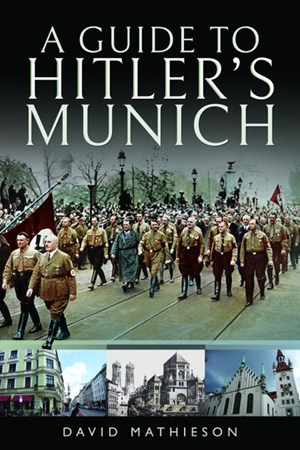A GUIDE TO HITLER'S MUNICH
Author: David Mathieson
Publisher: Pen & Sword, 193 pages, 29 Photographs, 4 maps
Published: May 2020
Price: £19.99
ISBN: 9781526766250
REVIEW: Munich, the capital of Bavaria, is one of Europe´s most enchanting cities with its criss-cross of narrow cobbled streets or wide sunlight boulevards. But it is also a city that hides a darker history. I wonder how many visitors on their business trips, city breaks or maybe attending the legendary Octoberfest know Munich was the location for the ascent of Nazism, the Third Reich and Adolf Hitler. Whilst dark tourism may not be to everyone’s tastes, if you have the opportunity to visit this city, reading this book with help you unlock its more sinister past.
In clear and concise chapters Mathieson’s book tells the story of Munich’s murky world of beer Keller politics. From the early life of Adolf Hitler, set against the backdrop of German political crisis and economic collapse, he tells the story of the rise of the NSDAP (Nazi party) and the path to world war. Through the books initial chapters is the story of the Beer Hall Putsch of 1923, told in a chapter titled from Bürgerbräu Keller to Landsberg Prison. Sites such as the apartment Hitler stayed in during the 1920s, the army barracks where he was once stationed, incidentally not far from the flat that Vladimir Lenin once lodged. The key locations of the putsch, the failed attempt for Hitler to take power in 1923, are described in interesting detail and the trial and imprisonment of Hitler that led to the writing of the infamous manifesto “Mein Kampf”. Other sites include the Löwenbräu Keller and the Bavarian War Ministry, even the building where the trial of Hitler and General Ludendorff took place. Each historical location is marked on associated maps to make them easier to find, although it should be noted that few architectural vestiges now remain. Other chapters include the sites associated with events such as the Night of the Long Knives and anti-Nazi resistance in the shape of The White Rose movement and Hans and Sophie Scholl. Today there is a memorial where the bomb was planted by the lone assassin, Georg Elser, who nearly killed Hitler in the Bürgerbräu Keller in November 1939, and another to the White Rose student leaflets, and of course the White Rose Memorial Museum itself.
The book also mentions the Kristallnach and the persecution of the Jews, especially important as the notorious Dachau Concentration Camp, located in a suburb of Munich, is probably the biggest draw in dark tourism in the area. In the final and fitting chapter titled Nuremberg, a location also close to the city, the final end and judgement of Nazi leadership is described. If you do visit Munich, and a visit is highly recommended even if you have no interest in the Second World War, Dachau, Nuremberg and also the Berchtesgaden are recommended, although they are not covered in any great detail in this book.
Mathieson’s book is a good detailed read on Munich, although it must be stated that it is more of a book than a travel guide. That said, if you fully digest each chapter before you visit and keep the book handy to refresh your knowledge, and of course refer to the detailed maps and supporting photographs, locating each site should be straightforward. The book doesn’t suggest any particular route, but as the area of interest is quite contained, it would not be that difficult to mark out your own walks. Recommended reading; a handy travel partner to help explore Munich’s murkier past.
Pen & Sword Link: https://www.pen-and-sword.co.uk/A-Guide-to-Hitlers-Munich-Paperback/p/17653


